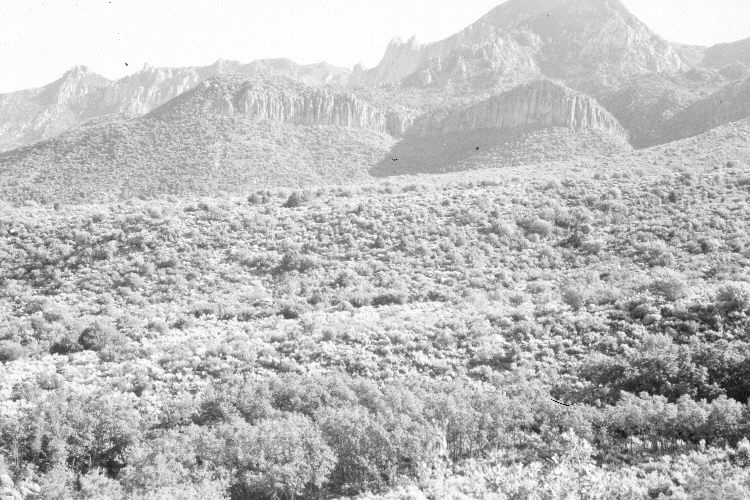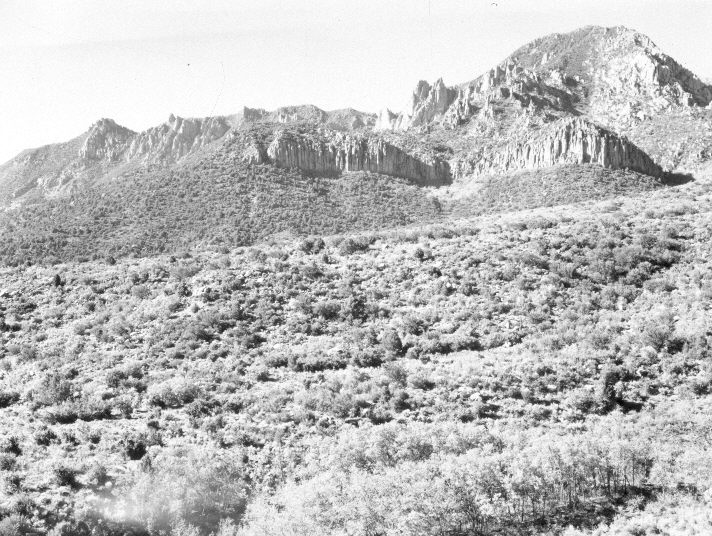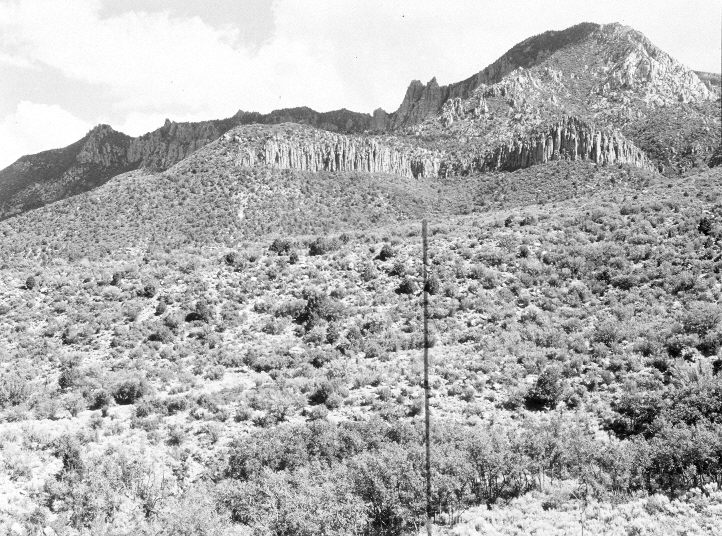Carter Canyon
1943

1953

1961

Description:
Plate 737X. Carter Canyon 1943 – 1953 – 1961 – 2004 This Photo Plot Transect was designed to monitor range conditions on the Blake-Gubler Ranch in Carter Canyon east of Red Knoll. According to Walter Cottam, who established this transect in 1943, “the entire area…is very heavily overstocked with deer and possibly cattle. Droppings of deer are so numerous in places as to resemble a bedground of sheep. As a consequence of this heavy spring, fall and winter concentration of deer, shrubs are badly hedged and highlined. Cercocarpus montanus [birchleaf mountain mahogany] is in very low vigor. Most shrubs of Garrya flavescens [yellowleaf silk tassel] have in the recent past been almost killed and new shoots now survive [only] under the protection of stiff dead branches.” Irwin Johnson remeasured the transect in 1953 and reported little improvement. “Poor to very poor condition browse-sagebrush range at 7,000 feet elevation is sampled by this transect…the area is summer range for cattle and almost year-long range for deer. It has been heavily grazed for many years. The better herbaceous species are very sparse and generally confined to the protection of shrubs. Although ten years have elapsed since transect establishment, the vegetation has not changed much, possibly because the range has been in such a depleted condition for so long….Gambel oak is mostly badly hedged on both bench and draw areas. The same for Amelanchier spp. [Utah serviceberry], Garrya flavescens, the sparse Purshia [bitterbrush] and Cercocarpus montanus and much of the Cercocarpus ledifolius [curlleaf mountain mahogany]. Fresh and old deer signs are abundant. Old cattle signs also indicate heavy use for many years by livestock…The openings which make up a large part of the transect area, are subject to effects of splash and sheet erosion. Litter except for some coarser, woody material is confined largely to shrub protection. Erosion pavement covers many of the openings. The conclusion, therefore, is that soil trend is downward…” Johnson measured the transect again in 1961 but found little had changed. “Having known this range between 1940 and late 1946 while serving as the Pine Valley District Ranger, then making a recheck of the transect in 1953 and again now, there is not much new to be said about the transect area. It was in a seriously depleted status in 1943 when I assisted Dr. W.P. Cottam in establishing the transect. Today it is still in the same condition if not worse (if this is possible). This applies to both the vegetation and the soil…fresh and old cattle signs are abundant as livestock try to get another mouthful of forage on range sadly depleted of the grazing resource. Their forage must come almost entirely from browse, which is already heavily grazed by deer. Fresh and old deer signs are abundant. All along the transect line fresh droppings are so numerous as to suggest that a sheep herd had closely used this range and repeatedly bedded or shaded up along the transect line. Old deer droppings are very dense in places. Active sheet erosion is widespread and serious. Rocks are being further exposed or covered up. All this is reflected in the presence of many active shallow to deep drainageways. The results of summer storms of this season is everywhere apparent (new cutting, alluvial deposits, etc.). Litter is practically all from woody species, plus cow and deer droppings. It is unfortunate that an area has become as depleted as this one has. It is certainly not cow range in thinking of range suitable for cattle in the usual terms….in reviewing all the information and data presented in this analysis report and in the attached general observation note and picture supplements, it is concluded that both vegetation and soil trends continue to be downward and to a marked degree. It is unfortunate that range such as this be grazed by livestock and that deer numbers are not more in balance with the available supply of
Vegetative Community:
Pinyon, Juniper, Mountain Brush
Location:
South West:


 Utah 4-H & Youth
Utah 4-H & Youth